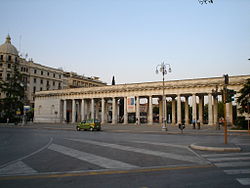Foggia, Italy
| Foggia | ||
|---|---|---|
| Comune | ||
| Comune di Foggia | ||

The Villa Comunale in Foggia
|
||
|
||
| Location of Foggia in Italy | ||
| Coordinates: 41°27′51″N 15°32′46″E / 41.46417°N 15.54611°ECoordinates: 41°27′51″N 15°32′46″E / 41.46417°N 15.54611°E | ||
| Country | Italy | |
| Region |
|
|
| Province / Metropolitan city | Foggia (FG) | |
| Frazioni | Arpinova, Incoronata, Cervaro, Tavernola, Segezia, Duanera La Rocca | |
| Government | ||
| • Mayor | Franco Landella (from 09/06/2014) | |
| Area | ||
| • Total | 507 km2 (196 sq mi) | |
| Elevation | 76 m (249 ft) | |
| Population (31/12/2013) | ||
| • Total | 153,143 | |
| • Density | 300/km2 (780/sq mi) | |
| Demonym(s) | Foggians | |
| Time zone | CET (UTC+1) | |
| • Summer (DST) | CEST (UTC+2) | |
| Postal code | 71121 - 71122 | |
| Dialing code | 0881 | |
| Patron saint | Madonna dei Sette Veli | |
| Saint day | March 22 | |
| Website | www |
|
Foggia ([ˈfɔddʒa]) is a city and comune of Apulia, in southern Italy, capital of the province of Foggia. In 2013 its population was 153,143. Foggia is the main city of a plain called Tavoliere, also known as the "granary of Italy".
The name Foggia derives from Latin "fovea", meaning "pit", referring to the pits where wheat was stored. Although the area had been settled since Neolithic times, and a Greek colony known as Argos Hippium (in Greek, Ἀργόριππα or Ἀργύριππόι) existed nearby, the first document attesting the existence of the modern city dates from 1000 AD. According to the legend, the first settlers were peasants who had found a panel portraying the Madonna, on which three flames burnt.
The area was marshy and unhealthy. Robert Guiscard directed draining the wetland, boosting the economic and social growth of the city. The city was the seat of Henry, Count of Monte Sant'Angelo during the last twenty years of the 11th century. In the 12th century, William II of Sicily built a cathedral here and further enlarged the settlement.
Frederick II had a palace built in Foggia in 1223, in which he often sojourned. It was also seat of his court and a studium, including notable figures such as the mathematician and scholar Michael Scot, but little of it remains now. In 1447, King Alfonso V of Aragon built a Custom Palace to tax the local sheep farmers. This caused a decline of the local economy and the progressive ruin of the land, which again became marshy. In 1456, an earthquake struck Foggia, followed by others in 1534, 1627 and 1731, the last destroying one third of the city. The House of Bourbon promoted a certain economic growth by boosting the cereal agriculture of Capitanata and rebuilding much of the settlement.
...
Wikipedia


